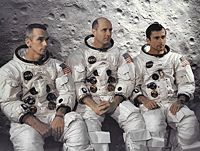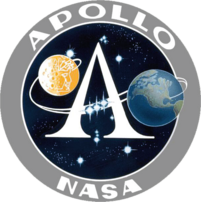Apollo 10
| Apollo 10 | |||||
Mission insignia |
|||||
| Mission statistics[1] | |||||
|---|---|---|---|---|---|
| Mission name | Apollo 10 | ||||
| Command Module | CM-106 callsign Charlie Brown mass 28,830 kg |
||||
| Service Module | SM-106 | ||||
| Lunar Module | LM-4 callsign Snoopy mass 13,941 kg |
||||
| Crew size | 3 | ||||
| Booster | Saturn V SA-505 | ||||
| Launch pad | LC 39B Kennedy Space Center Florida, USA |
||||
| Launch date | May 18, 1969 16:49:00 UTC |
||||
| Total CSM time in lunar orbit | 2 d 13 h 37 m 23 s | ||||
| Landing | May 26, 1969 16:52:23 UTC |
||||
| Mission duration | 8 d 00 h 03 m 23 s | ||||
Crew photo Left to right: Cernan, Stafford, Young |
|||||
| Related missions | |||||
|
|||||
Apollo 10 was the fourth manned mission in the Apollo program. The mission included the second crew to orbit the Moon and an all-up test of the lunar module (LM) in lunar orbit. The LM came to within 8.4 nautical miles (15.6 km) of the lunar surface during practice maneuvers.
According to the 2001 Guinness World Records Apollo 10 set the record for the highest speed attained by a manned vehicle at 39,897 km/h (11.08 km/s or 24,791 mph). The speed record was set during the return from the Moon on May 26, 1969.
While not included in the official mission logo due to the use of their names only as callsigns, the Peanuts characters Charlie Brown and Snoopy became semi-official mascots for the mission.[2][3] Peanuts creator Charles Schulz also drew some special mission-related artwork for NASA.
Contents |
Crew
Number in parentheses indicates number of spaceflights by each individual prior to and including this mission.
- Thomas P. Stafford (3) - Commander
- John W. Young (3) - Command Module Pilot
- Eugene A. Cernan (2) - Lunar Module Pilot
Backup Crew
- L. Gordon Cooper, Jr - Commander
- Donn F. Eisele - Command Module Pilot
- Edgar D. Mitchell - Lunar Module Pilot
Support Crew
- Charles M. Duke, Jr
- Joseph H. Engle
- James B. Irwin
- Jack R. Lousma
Flight Directors
- Glynn Lunney, Black team
- Gerry Griffin, Gold team
- Milton Windler, Maroon team
- Pete Frank, Orange team
Mission Parameters
- Mass: CSM 28,834 kg; LM 13,941 kg
Earth Orbit
- Perigee: 184.5 km
- Apogee: 190 km
- Inclination: 32.5°
- Period: 88.1 min
Lunar Orbit
- Perilune: 111.1 km
- Apolune: 316.7 km
- Inclination: 1.2°
- Period: 2.15 hours
LM - CSM Docking
- Undocked: May 22, 1969 - 19:00:57 UTC
- Redocked: May 23, 1969 - 03:11:02 UTC
LM closest approach to lunar surface
- May 22, 1969, 21:29:43 UTC
On May 22, 1969 at 20:35:02 UTC, a 27.4 second LM descent propulsion system burn inserted the LM into a descent orbit of 112.8 km by 15.7 km so that the resulting lowest point in the orbit occurred about 15° from lunar landing site 2 (the Apollo 11 landing site). The lowest measured point in the trajectory was 15.6 km above the lunar surface at 21:29:43 UTC.
Mission Highlights
This was the first manned space mission to contain an all-veteran crew.
This dress rehearsal for a Moon landing brought Stafford and Cernan's lunar module Snoopy to 8.4 nautical miles (15.6 km) from the lunar surface. Except for that final stretch, the mission went exactly as a landing would have gone, both in space and on the ground, where Apollo's extensive tracking and control network was put through a dry run.
Shortly after leaving low Earth orbit, the command/service module separated from the S-IVB stage, turned around, and docked its nose to the top of the lunar module still nestled in the S-IVB. The CSM/LM stack then separated from the S-IVB for the trip to the moon.
Upon reaching lunar orbit, Young remained alone in command module Charlie Brown while Stafford and Cernan flew separately in the LM. The LM crew checked out their craft's radar and ascent engine, rode out a momentary gyration in the lunar lander's motion (due to a faulty switch setting), and surveyed the Apollo 11 landing site in the Sea of Tranquility. The lunar module on this flight was not equipped to land, however.
Apollo 10 added another first by broadcasting live color TV from space.
Hardware Disposition
The Apollo 10 LM ascent stage is in heliocentric orbit making it the sole intact lunar module ascent stage remaining out of the 10 true LMs sent into space. The Apollo 5, 9, 13 LM ascent stages burned up in Earth's atmosphere (as did the Lunar Test Article LTA-B flown as ballast aboard Apollo 8), the Apollo 11 and 16 LM ascent stages were left in lunar orbit and crashed onto the moon when their orbits decayed, and the Apollo 12, 14, 15 and 17 LM ascent stages were deliberately crashed onto the moon.
The Apollo 10 LM descent stage is expected to have crashed onto the lunar surface, but the exact location is unknown.
The Apollo 10 Command Module Charlie Brown is on display at the Science Museum in London.
Mission Insignia
The shield-shaped emblem for the flight shows a large, three-dimensional Roman numeral X sitting on the moon's surface, in Stafford's words, "to show that we had left our mark." Although it did not land on the moon, the prominence of the number represents the significant contributions the mission made to the Apollo program. A CSM circles the moon as an LM ascent stage flies up from its low pass over the lunar surface. The earth is visible in the background. A wide, light blue border carries the word APOLLO at the top and the crew names around the bottom. The patch is trimmed in gold.
Images
See also
- Splashdown (spacecraft landing)
- List of artificial objects on the Moon
Notes
References
- NASA NSSDC Master Catalog
- APOLLO BY THE NUMBERS: A Statistical Reference by Richard W. Orloff (NASA)
- Apollo 10 Characteristics - SP-4012 NASA HISTORICAL DATA BOOK
- Lattimer, Dick (1985). 'All We Did was Fly to the Moon. Whispering Eagle Press. ISBN 0-9611228-0-3.
External links
- Apollo 10 entry in Encyclopedia Astronautica
- The Apollo Spacecraft: A Chronology
- Apollo Program Summary Report
- Mission Report: Apollo 10
- Apollo 10 Moon Orbit Video
- More images from Apollo 10
- Apollo/Saturn V Development Apollo 10 Launch ApolloTV.net Video
|
|||||||
